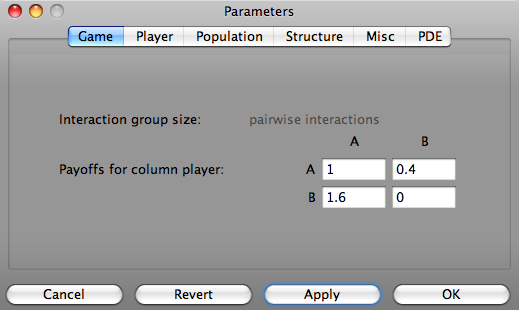Parameters
A word of warning: In perfect agreement with the vast majority of software projects, the code of the VirtualLabs tends to evolve much faster than the technical documentation... Therefore, this page may contain outdated or incomplete information - please bear with me or, even better, leave your questions, comments and corrections on the talk page.
Clicking on the Params button of the VirtualLabs applets opens a panel to change various parameter settings:

Panel to set the game parameters
This panel depicts the game parameters for 2×2 Games.
The parameters are divided into different categories: Game, Player, Population, Structure, Misc and possibly PDE. For a brief description of each parameter group click the tabs on the image above or follow the links below.
- Game
- Group of parameters that characterizes the interaction between individuals.
- Player
- Group of parameters describing the propagation of strategies.
- Population
- Group of parameters specifying the size of the population and the updating procedure.
- Structure
- Group of parameters defining the structure of the population.
- Misc
- Group of parameters determining the initial configuration, mutation rates, migration rates etc.
- PDE
- Group of parameters to control and fine tune the numerical integration of partial differential equations. This is not available for all types of models/games.
The buttons along bottom of the parameter panel apply or discard new settings.
- Cancel
- Closes the parameter panel and discards changes of the parameters leaving all settings untouched.
- Revert
- Discards parameter changes and reverts all parameters to the current setting of the simulation engine.
- Apply
- Applies and verifies new parameter settings. Parameters that did not pass verification are adjusted to acceptable values. Details concerning parameter adjustments are provided on the Console.
- OK
- Applies new parameter settings and closes the parameter panel.
Game
This group of parameters is game specific and is varies for the different types of virtual labs. Generally you will find here parameters that determine e.g. the costs and benefits of cooperative behavior and the initial frequencies of the different strategies or the range of initial strategies, respectively.